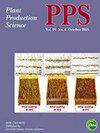Estimation of grain quality of rice (Oryza sativa L.) by UAV-acquired vegetation index and climate factors
IF 1.3
3区 农林科学
Q2 AGRONOMY
引用次数: 0
Abstract
ABSTRACT We aimed to associate unmanned aerial vehicle – acquired vegetation index (VI) with the percentage of several kinds of imperfect grains and grain protein content (GPC) for use as an indicator of rice grain quality. The cultivars ‘Koshihikari’ and ‘Ishikawa 65’ were grown in the field from 2019 to 2022 at various N application rates. From 20 days before heading to 10 days after heading, the field was imaged with a multispectral camera to construct VI maps. We measured the chlorophyll index at heading (CIG 0) and two climate factors, mean air temperature in the 20-day period after heading (T +20) and cumulative solar radiation in the 20-day period before heading (R −20). At maturity, we harvested plants to determine grain yield and quality. We assessed the percentages of two types of chalky grains basal-white and white-back grains (BBWG), milky-white grains (MWG), as well as other types of immature grains (OTG) and GPC. In Koshihikari, CIG 0 and climate factors were associated with BBWG and MWG, whereas in Ishikawa 65, they were associated with BBWG, MWG, and OTG. Based on these findings, the response of BBWG, MWG, OTG, and GPC to CIG 0 was estimated using the mean T +20 and R −20 values from the last 10 years. We found that as CIG 0 increases, the sum of BBWG and MWG decreases in Koshihikari, whereas the sum of BBWG, OTG, and MWG increases in Ishikawa 65. Thus, CIG 0 is an acceptable indicator of grain quality in rice. GRAPHICAL ABSTRACT利用无人机植被指数和气候因子估算水稻籽粒品质
摘要:我们旨在将无人机获取的植被指数(VI)与几种不完美谷物的百分比和谷物蛋白质含量(GPC)联系起来,作为稻米品质的指标。品种“Koshihikari”和“Ishikawa 65”于2019年至2022年在不同的施氮率下种植。从20 前往10日前几天 出发几天后,用多光谱相机对该区域进行成像,以构建VI地图。我们测量了抽穗期的叶绿素指数(CIG 0)和两个气候因素,即抽穗后20天的平均气温(T+20)和抽穗前20天的累积太阳辐射(R−20)。成熟时,我们收割植物以确定粮食产量和质量。我们评估了两种类型的垩白颗粒——基白颗粒和白背颗粒(BBWG)、乳白色颗粒(MWG)以及其他类型的未成熟颗粒(OTG)和GPC的百分比。在Koshihikari,CIG 0和气候因素与BBWG和MWG相关,而在Ishikawa 65,它们与BBWG、MWG和OTG相关。基于这些发现,BBWG、MWG、OTG和GPC对CIG 0的响应是使用最近10次的平均T+20和R−20值来估计的 年。我们发现,随着CIG 0的增加,Koshihikari的BBWG和MWG之和减少,而Ishikawa 65的BBWG、OTG和MWG的总和增加。因此,CIG0是一个可接受的稻米品质指标。图形摘要
本文章由计算机程序翻译,如有差异,请以英文原文为准。
求助全文
约1分钟内获得全文
求助全文
来源期刊

Plant Production Science
农林科学-农艺学
CiteScore
5.10
自引率
4.00%
发文量
27
审稿时长
>36 weeks
期刊介绍:
Plant Production Science publishes original research reports on field crops and resource plants, their production and related subjects, covering a wide range of sciences; physiology, biotechnology, morphology, ecology, cropping system, production technology and post harvest management. Studies on plant production with special attention to resource management and the environment are also welcome. Field surveys on cropping or farming system are also accepted. Articles with a background in other research areas such as soil science, meteorology, biometry, product process and plant protection will be accepted as long as they are significantly related to plant production.
 求助内容:
求助内容: 应助结果提醒方式:
应助结果提醒方式:


